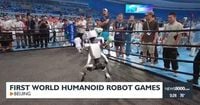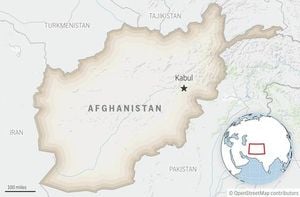The world of sports just witnessed a spectacular leap into the future as Beijing hosted the inaugural World Humanoid Robot Games from August 14 to August 17, 2025. Held at the iconic National Speed Skating Oval, this unprecedented event drew over 500 humanoid robots and nearly 280 teams from 16 countries, all vying for glory in a competition that fused athleticism, engineering, and artificial intelligence.
For four days, the arena buzzed with excitement as robots sprinted, boxed, danced, and even performed kung fu. The spectacle wasn’t limited to traditional sports—these high-tech competitors also tackled practical challenges like medicine sorting, home cleaning, and even hotel housekeeping. It was part Olympics, part tech carnival, and all about pushing the boundaries of what robots can do.
The event’s significance went far beyond medals and trophies. As the world’s first large-scale international competition for humanoid robots, the Games were a bold statement of China’s ambition to lead the global robotics and artificial intelligence industries. The Chinese government has been vocal about its goal to build a world-class humanoid robot sector by 2027, and the Games served as both a showcase and a proving ground for the country’s technological prowess.
Among the standout performers was Hangzhou-based Unitree, a robotics company whose creations walked away with four gold medals. According to Engadget’s Jackson Chen, Unitree was the “big winner of the competition,” outshining other notable Chinese firms like Booster, Beijing-based X-Humanoid, and Hong Kong-listed UBTECH. The robots themselves, manufactured primarily by these homegrown companies, demonstrated feats of strength, agility, and coordination that left spectators in awe—at least, when everything went according to plan.
Of course, not every moment was picture-perfect. As with any new frontier, there were plenty of growing pains. Some robots stumbled during soccer matches, others lost their balance in track and field events, and in one memorable incident, a robot lost its head—literally—during a race. “Most teams took this event as an opportunity to showcase the abilities of their designs, while also stress-testing their robots in a competitive environment,” wrote Chen. The Games were as much about learning and innovation as they were about winning.
On the athletic front, the robots competed in a dizzying array of events: soccer, boxing, track and field (including the 400-meter and 1500-meter races, and the long jump), martial arts, and even dance battles. The soccer tournament featured both three-a-side and five-a-side matches, with AI-driven players darting across the pitch in pursuit of victory. And while the robots’ movements sometimes looked awkward or mechanical, their “stronger joints and core strength” wowed programmers like Guo Tong of Team Hephaestus. Guo, inspired by soccer legend Cristiano Ronaldo, told CNBC, “Robots have stronger joints and core strength. I see robots replacing my idol by 2050.”
Boxing, too, was a highlight—especially with the presence of Chinese Olympic boxer Li Yang, who lent his expertise to the event. Watching his robot slug it out in the ring, Li remarked, “Robots are easier to coach. Humans are emotional.” His observation captured a key advantage of these mechanical athletes: they’re programmable, tireless, and immune to nerves or fatigue. Yet, as the competitions revealed, even the best robots have their limits, sometimes struggling with tasks humans take for granted.
Practical challenges brought a different flavor to the Games. Robots were put through their paces in tasks like medicine sorting, mimicking the work of pharmacy clerks, and hotel housekeeping, where they had to pick up garbage and take out the trash in a mock hotel room. Referees noted that the biggest hurdle was something as simple as opening and closing doors—an everyday task that proved surprisingly tricky for even the most advanced machines. Robot designer Wang Xidong saw this as a valuable learning experience. “We are refining our robots,” Wang said. “Everyone feels motivated to compete.”
The technological backbone of the Games was just as impressive as the robots themselves. China Unicom’s Beijing division provided full 5G Advanced (5G-A) network coverage inside and outside the venue, ensuring seamless connectivity for both robots and tens of thousands of spectators. The network delivered uplink speeds above 100 Mbps indoors and downlink and uplink speeds of 10 Gbps and 4 Gbps outdoors. This allowed for instant robot command responses—air interface latency stayed below 20 milliseconds—and enabled live 4K and 8K video streaming without a hitch. “Our 5G-A network for this event reflects this progress,” said Qin Yang, deputy general manager of China Unicom Beijing. “It dedicates a channel for spectators and a dynamically scalable one for robots, realising seamless connectivity for both spectators and robots even during peak usage.”
Samuel Chen, vice-president of marketing for Huawei’s wireless network product line, emphasized the challenge: “At the humanoid robot games, the network [had to] support many robots, spectators and live-media streams. It needed to provide high uplink capacity, low latency, high reliability and wide coverage.” The robust communications infrastructure was crucial, allowing robots to perceive their surroundings, make split-second decisions, and coordinate with teammates—all in real time.
Beyond the Games themselves, the event marked a turning point in the integration of AI and robotics into everyday life. The robots’ participation in industrial and healthcare contests hinted at a future where humanoid machines play vital roles in factories, hospitals, and homes. China’s ambitious plans to hold a second Olympics-style event for humanoid robots next August underscore the country’s commitment to staying at the forefront of this technological revolution.
For now, the 2025 World Humanoid Robot Games stand as both a landmark achievement and a glimpse into what lies ahead. The event wasn’t just about who took home the most medals—it was about testing the limits of robotics, learning from every stumble, and fueling the race to bring intelligent machines out of the lab and into the real world. With China leading the charge and the rest of the world close behind, the next chapter in sports—and perhaps in society itself—may well be written by robots.





